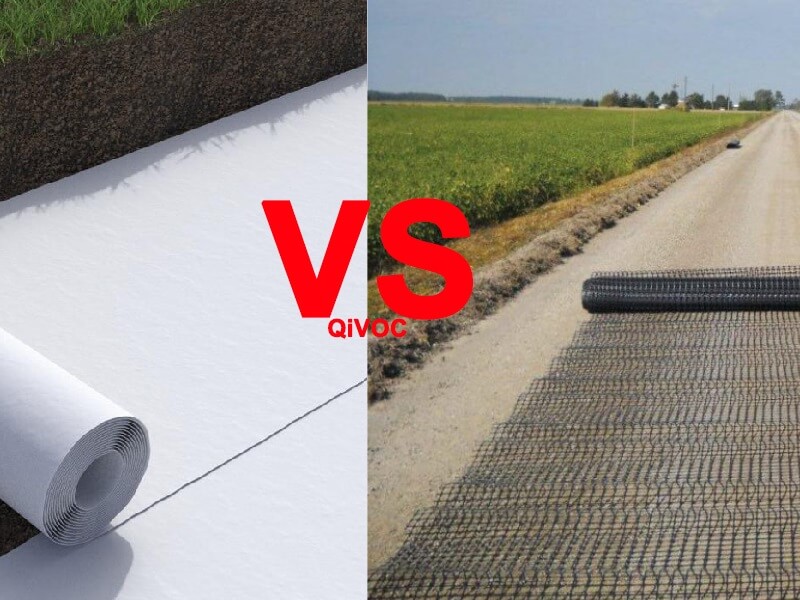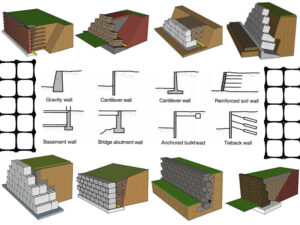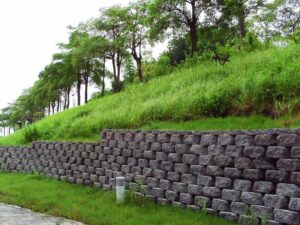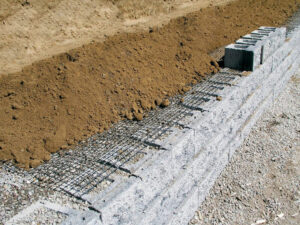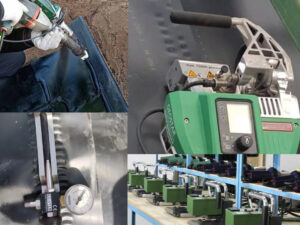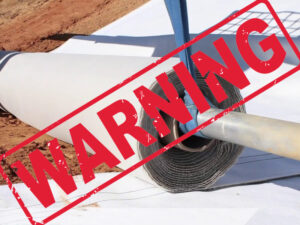Geosynthetics are used in engineering construction instead of traditional geomaterials, which have the advantages of low price, durability, easy and simple installation, and short production cycle. Among the geosynthetics, geogrid and geotextile are the most common synthetic materials. So do you know what the difference is between them?
In this article, QIVOC will introduce in detail what are the differences between geogrid and geotextile.
Geosynthetics Overview
What are geosynthetics?
Geosynthetics is a collective term for various products made from synthetic materials used in geotechnical and civil engineering construction. Because they are mainly used in geotechnical engineering, they are called “geosynthetics” with the word “geo” to distinguish them from natural materials. As a civil engineering material, it is a synthetic polymer (such as plastics, chemical fibers, synthetic rubber, etc.) as raw materials, made of various types of products, placed inside the soil, the surface of the soil, or a variety of soil between the body, to play a role in strengthening or protecting the soil.
Geosynthetics was once known as “geotextiles” and “geomembranes“. With the needs of the project, such materials continue to have new varieties, such as geogrids, geonets and geotechnical bags, geonet mats, geobelts, geomembranes, composite geomembranes, bentonite waterproofing blankets, composite drainage network, etc., the original name can not be accurately cover all the products so that in the subsequent period of time, they are called “geotextiles, geomembranes and related products “. Such a name is not suitable as a technical or academic term. For this reason, in 1994, held in Singapore, the Fifth International Geosynthetics Conference, the name of such materials was formally identified as “geosynthetics” (geosynthetics).
The raw materials of geosynthetics are polymers (polymer). They are made from chemicals derived from coal, oil, natural gas or limestone, which are further processed into fibers or sheets of synthetic materials, and finally into a variety of products. The main polymers used in the manufacture of geosynthetics are polyethylene (PE), polyester (PET), polyamide (PER), polypropylene (PP), and polyvinyl chloride (PVC), chlorinated polyethylene (CPE), and polystyrene (EPS).
Main uses and functions of geosynthetics
The fields of geosynthetics are geotechnical engineering, civil engineering, water conservancy engineering, environmental engineering, transportation engineering, municipal engineering and sea enclosure engineering.
In these fields, geosynthetics mainly play the roles of soil reinforcement, anti-seepage, anti-corrosion, isolation and enhancement.
Enhance the strength of the soil body
Geosynthetics have high tensile strength and shear strength, which can form a reinforcing layer in the soil body and improve the overall strength and stability of the soil body. For example, in road engineering, by laying geosynthetics at the bottom of the roadbed, it can effectively resist the action of vehicle load and prevent the road surface from subsidence and deformation.
Improvement of soil engineering performance
Geosynthetics have excellent filtration and drainage properties, which can improve the drainage capacity and seepage resistance of the soil. In the earth and rock dam project, by laying geosynthetics inside the dam body, the seepage resistance of the dam body can be improved, preventing water seepage and outbursts from occurring.
Improvement of soil scour resistance
In river and coastal engineering, geosynthetics can effectively resist the scouring of water, prevent soil erosion and siltation of sediments, and protect the stability and safety of engineering structures.
Playing the role of isolation and anti-corrosion
In underground engineering, installing geosynthetics in the soil, it can isolate water flow and particle migration between different soil layers and prevent groundwater pollution and soil subsidence. In environmental projects such as landfills, geosynthetics can play a role in preventing corrosion and seepage, protecting the safety and health of the surrounding environment.
Increase soil availability
By adding geosynthetics to the soil, the physical and chemical properties of the soil can be changed, and the fertility and permeability of the soil can be improved, providing favorable conditions for agricultural production and vegetation restoration.
Geogrid
What is Geogrid
Geogrid is a type of geosynthetic material with unique properties and efficacy. Commonly used as reinforced soil structure of the rib material or composite materials, such as the rib material.
Geogrid is divided into four categories: plastic geogrid, steel geogrid, glass fiber geogrid, and polyester warp knit polyester geogrid. Grid is made of polypropylene, polyvinyl chloride, and other polymers by thermoplastic or molded two-dimensional grid or a certain height of three-dimensional grid screen, when used as civil engineering, known as geogrid.
Properties and structure of geogrids
Geogrid has the following characteristics
1, high strength, small deformation;
2, small creep;
3, corrosion resistance, long life;
4, convenient and quick construction, short cycle, low cost;
The structure of geogrid includes:
Uniaxial
Uniaxial tensile plastic geogrid has extremely high tensile strength and tensile modulus. This kind of plastic geogrid is made of high-density polyethylene (HDPE) as the main material extruded into a thin sheet, punched to form a regular grid, and then stretched longitudinally.
Biaxial
Biaxial geogrids have significant tensile strength in both the longitudinal and transverse directions. Biaxial monolithic geogrid products are made of polypropylene (PP) or polyethylene (PE), plasticized, extruded, perforated, and stretched longitudinally and transversely.
Multi-axial
Multi-axial geogrid stands out for its enhanced stability and efficiency, providing a more rational state of stress. It not only ensures the stability of the foundation but also has the advantages of sufficient tensile and shear strength. This plastic geogrid layer has a planar mesh structure formed by plastic extrusion, punching, and four-way stretching.
Geogrid Main Application Scenarios
Road and railroad foundation reinforcement
The role of geogrid for highway and railroad roadbeds is to reinforce to restore its bearing capacity and smoothness, as well as to strengthen the stability of the roadbed soil body, increase the service life and reduce routine maintenance.
Geogrid polymer can add a very high degree of stability to the roadbed, and improve the overall strength of the soil body, reinforcement can significantly improve the strength of gravel soil and destructive strain, and the destruction of the soil has a delayed effect. At the same level of destructive stress, the axial strain and lateral strain of the reinforced gravel soil specimen are significantly reduced. The reinforcing effect of gravel soil decreases with the increase of perimeter pressure, and the reinforcing effect is also related to the weathering degree, softness and hardness of gravel particles.
Stabilization of walls and slopes
Walls and slopes are subjected to great pressure from the soil, and geogrids can evenly distribute this pressure to the entire retaining wall structure, thus increasing the overall stability of the retaining wall. At the same time, geogrids can also prevent sliding and erosion of the soil and maintain the integrity of the retaining wall.
Earthquake is a common natural disaster, that poses a great threat to the stability of walls and slopes. The geogrid has good flexibility and ductility, which can effectively absorb and disperse the impact caused by the earthquake, reduce the vibration of the retaining wall, and improve its seismic performance.
Water permeability is an important consideration in the construction of walls and slopes. If the permeability of walls and slopes is not good, it will lead to the accumulation of water pressure and increase the pressure, thus affecting their stability. Geogrids, on the other hand, have good water permeability and can effectively drain water, reducing the impact of water pressure on retaining walls.
Walls and slopes often need to withstand the pressure of the soil and the influence of the external environment for a long time, so their durability is an important consideration. Geogrid is characterized by corrosion resistance and aging resistance, which can effectively extend the service life of walls and slopes.
For more information on geogrids, read this article “Unraveling the Fabric of Geogrids: A Comprehensive Guide ”
Geotextile
What is Geotextile
A geotextile is a permeable synthetic material made from synthetic fibers (e.g., polypropylene fibers, polyester fibers, glass fibers) by needling or weaving. As a permeable textile, it can separate, filter, reinforce, protect, or drain when used in combination with soil. As such, it is widely used in civil engineering and various construction projects aimed at achieving specific functions in geotechnical and environmental applications.
Main characteristics and types of geotextiles
Properties of geotextiles
High Strength: Retains ample strength and elongation in both wet and dry conditions, thanks to the use of plastic fibers.
Corrosion Resistance: Exhibits long-term resistance to corrosion in soils and waters with varying pH levels.
Good Water Permeability: The presence of gaps between fibers ensures excellent water permeability.
Good Anti-Microbial Properties: Remains undamaged by microorganisms and insects.
Convenient Construction: Its light and soft nature make it easy to transport, lay, and construct.
Excellent Anti-Aging Properties: Boasts exceptional resistance to aging, including anti-ultraviolet, anti-ozone, and anti-oxidation properties, ensuring stable use across diverse climate conditions.
Environmentally Friendly: Primarily composed of synthetic fibers, reducing reliance on natural resources.
Lightweight: Compared to traditional civil engineering materials, it is lighter and facilitates easier transport, installation, and construction.
Good Isolation: Effectively isolates soil from sand, and soil from concrete, among other applications.
Good Filtration/Reverse Filtration: Effectively intercepts soil particles, fine sand, small stones, etc., ensuring the stability of water and soil engineering.
Types of geotextiles
Woven geotextile is crafted from yarns intricately interwoven in a regular pattern. Due to its uniform distribution, it exhibits outstanding strength and dimensional stability compared to non-woven geotextile fabric. Primarily employed to prevent soil movement, restrict underground drainage, and reinforce texture control, these fabrics are also utilized in stabilizing railway tracks.
Non-woven geotextile is manufactured from thermally bonded synthetic fibers, offering lightweight and pliable characteristics. Primarily used for separation and filtration applications, reinforcing retaining walls, soil stabilization, and erosion control, non-woven fabrics possess permeability, excellent puncture resistance, moderate tensile strength, and impressive elongation properties.
Polypropylene Geotextile Fabric:
Polypropylene geotextile fabric is a non-woven fabric primarily designed for separation. While they possess permeability and drainage capabilities, they do not provide any reinforcement for projects. Polypropylene geotextile fabric is commonly referred to based on its lifespan and is frequently used as a weed barrier.
Spunbond Geotextile Fabric:
In the realm of fabric manufacturing, the spunbond process is considered the fastest method for producing non-woven fabric. In this process, extruded filaments are spun into sheets and bonded through heated rollers. Similar to polypropylene geotextile fabric, spunbond fabrics offer drainage capabilities but lack reinforcement. Calculated by weight, they are typically used as weed barriers or drainage fabrics.
Knitted Geotextile Fabric:
These textiles exhibit excellent flexibility and high cost-effectiveness. Despite their lower usage, the demand for “drainage and erosion control” is steadily increasing. Knitted geotextile fabrics are produced using knitting techniques, and sometimes weaving is also employed in their manufacturing.
Composite Geotextile Fabric:
These are created by combining two or more geotextile fabrics to form a material with unique properties. For instance, composite geotextile fabrics may combine non-woven geotextile fabric with woven geotextile fabric to produce a sturdy, durable, and highly permeable material.
Polyester Geotextile Fabric:
Polyester geotextile fabric is made from curled short fibers of polyester, with a fiber fineness of 6-12 deniers and a length of 54-64 millimeters. The production process involves opening, carding, blending (interlacing short fibers), web laying (standardized knotting and fixing), and needle-punching techniques using non-woven fabric production equipment to create the fabric.
Polyester Filament Geotextile Fabric:
Polyester filament geotextile fabric is made from polyester geotextile fabric material through spinning and needle punching. It exhibits excellent heat resistance and light resistance.
Continuous Filament Geotextiles:
These geotextiles are made from continuous fibers without the need for individual yarns or staple fibers. Continuous filament geotextiles are used for applications where high tensile strength and filtration are essential.
Biodegradable Geotextiles:
Biodegradable geotextiles are designed to break down over time, providing temporary support while vegetation is established. Commonly used in environmentally sensitive areas, these geotextiles help control erosion until natural vegetation takes over. Such as geotextiles made of natural fibers.
Main application scenarios for geotextiles
Separation and filtration
Utilize geotextile to isolate building materials (such as soil and sand, soil and concrete, etc.) with different physical properties (particle size, distribution, consistency and density, etc.). So that two or more kinds of materials are not lost, not mixed, to maintain the overall structure and function of the material, so that the building carrying capacity strengthens.
When water flows into the coarse material soil layer from the fine material soil layer, the geotextile is utilized for its good air permeability and water permeability to make the water flow through, while effectively intercepting the soil particles, fine sand, small stones, etc. to maintain the stability of the soil and water works.
Drainage and seepage control
Geotextile has good water-conducting properties, it can form drainage channels inside the soil body, and drain excess liquid and gas out of the soil structure.
The seepage control function of geotextile mainly refers to the prevention of infiltration of water or harmful liquids. This kind of geotextile is mainly composed of nonwoven fabric and geomembrane. It is mainly used for seepage control of dams reservoirs and landfills, such as seepage control sloping walls of dams, berms and channel seepage control.
Erosion Control
Geotextiles can be used to control water flow and prevent land erosion caused by alternating droughts and floods on riverbanks, riverbeds and beaches.
During construction, geotextiles can prevent soil settlement caused by traditional compaction methods.
In roads, bridges, tunnels, tower foundations, etc., geotextiles can be used to strengthen or reinforce the soil, making it stronger and more stable.
For more information on geotextiles, read this article “Demystifying the Power of Geotextile Fabrics”
Difference between geogrid and geotextile
Geogrids are mainly used for reinforcement and stabilization
Geogrid can effectively improve the stability of soil. Adding geogrid to the soil can form a reinforced soil effect, locking the soil particles in the grid of the grids, thus greatly improving the shear strength and bearing capacity of the soil. This is important for preventing soil erosion, landslides, and foundation subsidence.
Geotextiles are mainly used for separation, filtration and drainage
The separation mechanism of geotextile is: firstly, the geotextile is arranged between two different geotechnical materials, which plays the role of isolation between the two materials and prevents the adulteration of materials between different layers. The second is to prevent pollution and corrosion between the layers to ensure a high standard of engineering construction.
The filtration mechanism of geotextile is: first, to ensure that liquids and gases are not intercepted when they are freely discharged; second, to effectively keep small soil particles through the flow of water, and to protect the soil from damage.
Geotextile can realize the function of drainage in the soil, similar to a drainage channel. It drains water in all directions of the soil and collects and transports water or other liquids in geotechnical works.
Differences in structure and material
Geogrids have a grid-like structure
The mesh structure of geogrid mainly includes uniaxial, biaxial, and multiaxial structures.
Geotextile is a continuous fiber structure
The continuous fiber structure of geotextile is mainly made through the needle punching or weaving process of two types of geotextiles.
One type is nonwoven, because nonwoven geotextile is a repeatedly needled production process, so it has a three-dimensional pore structure, customarily called equivalent pore size.
The other type is woven geotextile, which is woven into cloth by interweaving the warp and weft yarns together through different weaving equipment and processes.
Difference in application environment
Geogrids are suitable for projects with high-strength requirements
1. Road project
In the road project, geogrid can be used to strengthen the roadbed, improve the bearing capacity of the road surface, and prevent the road surface from cracking. In the highway, city roads and other projects, the use of geogrid for reinforcement, can significantly improve the service life of the road surface and driving safety.
2. Railroad project
In the railroad project, geogrid can be used to strengthen the railroad roadbed and improve the stability and safety of the railroad line. In heavy railroad, high-speed railroad and other projects, the use of geogrid for reinforcement, can effectively prevent the settlement and deformation of the roadbed, and improve the operational efficiency and safety of railroad lines.
3. Water conservancy project
In water conservancy engineering, geogrid can be used to reinforce embankments, prevent riverbank erosion, strengthen reservoir dams and so on. In river
governance, reservoir construction and other projects, the use of geogrid for reinforcement can improve the stability and safety of the project, to protect people’s lives and property safety.
4. Construction engineering
In construction engineering, geogrid can be used for foundation reinforcement, basement waterproofing, soil slope stabilization and so on. In high-rise buildings, basements and other projects, the use of geogrid for reinforcement can improve the bearing capacity and stability of the foundation to ensure the safety and stability of the building.
Geogrids are suitable for scenes that require separation and filtration
1. Road construction
In the process of road construction, stone is often used as road pavement material. By laying geotextile in the stone layer, it can play the role of separation, filtration and enhancement to extend the service life of the road.
2. Water conservancy project
In water conservancy projects, geotextile can be laid on the inside of the embankment to protect the embankment structure. At the same time, it can also be laid on the stone dam to enhance the stability of the stone dam and resist the water scour.
3. Mining project
In the mining project, geotextile can be laid between the stone steps to strengthen the bearing capacity of the stone steps and prevent the stone from loosening.
Combined application
When building roads, geogrid and geotextile can be used in combination.
For example, geogrid is laid at the bottom of the roadbed, and filament geotextile is laid under the asphalt surface layer when repairing the road.
Geogrid laid on the roadbed can increase the bearing capacity of the road and prevent soft base subsidence.
Geotextile laid under asphalt can prevent cracking of the road surface and prolong road life.
Summary
The main difference between geogrids and geotextiles lies mainly in the differences in realized functions, types, structural properties, and so on. Although they belong to the same category of geosynthetics, they are two completely different geotechnical products.
Last but not least, we have provided examples of the use of these two products in combination. Therefore, when choosing materials, you need to choose according to the needs of the project or combine the advantages of different materials for combined use.
In the future, more types of geosynthetics will be developed, and QIVOC is actively exploring the development of geosynthetics with better quality and versatility.

